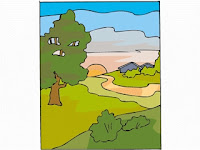Sunday, September 1, 2019
2019 September - Setting as Character
This is Part 9 of a 12-part series dealing with Story Settings
© 2019 All Rights Reserved
Setting can become like a character, or the focal character will refer to and be convinced that the setting or an element of their setting is like a person. Character as setting is also a staple trope of fiction.
For instance, The Spaceship (or space station) is like a large ocean liner. It breaks down at the most inopportune moment. And if the chief engineer or other fix-it person sweet talks it (or threatens to send it to the junk yard), the ship (or station) starts working again—and often saves the crew's lives.
However, don't confuse this with a Sapient Ship (one that thinks and talks like HAL in A Space Odyssey or V'ger from Star Trek or a Living Ship like Moya, the leviathan starship of Farscape. Such ships can wise and insightful or downright dastardly.
And don't forget about other setting transports, like cars, trucks, boats, airships, etc. Think Transformers or even Herbie the Volkswagen Beetle.
Then there is The City trope. The City is seen by the focal character as a living organism, perhaps a hive of millions that are forever changing The City's landscape and subsystems, building, expanding, or even tearing things down.
The City might be a magical forest land, swamp, or mountain in a fantasy realm.
Another type of setting trope is The Entity (that which is perceived or known or inferred to have its own distinct existence and can be living or nonliving. The Entity can be an alien species. Aliens can be humanoid or beasts. The Entity can be robots or machines (computers). Like human beings, some might be good, others not-so-good, and still others truly evil. Much will depend on the roll The Entity plays in the story.
However, when it comes to setting-as-a-character details, take the time to really think about the origins of that particular setting-as-a-character. Do the same for The Entity, those aliens, robots, or beasts that are part of the story world. After all, each is the product of some environment or some technology or some wizardry. You-the-writer need to know this, but the reader likely only needs to know the bare bones (ten percent) of it all.
And, as always, continue to strive to make the setting as believable and as logical as possible to the reader.
***WRITER'S ROAD TRIP #7, October 12, 2019, at the Tom Ridge Environmental Center, Erie PA (across from Waldameer Park). I'm doing two workshops at this one-day mini-conference for writers. The workshops are: the "3-Act Structure" of story and "Dynamic Dialogue."
This event is hosted by Pennwriters Area 1 (For information to - https://www.Pennwriters.org ) or visit the event's Facebook page at https://www.facebook.com/WritersRoadTrip
# # #
Subscribe to:
Post Comments (Atom)


2 comments:
Thanks, Catherine. I'm reading _The Overstory_ by Richard Powers. Trees, which readers usually consider setting, are characters. They intensify the drama.
Thank you for sharing this!
Post a Comment